Posts Tagged ‘Hildegard of Bingen’
Friday, May 10, 2013
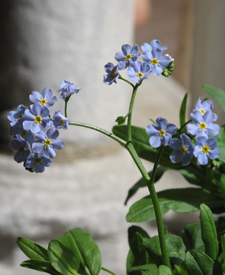
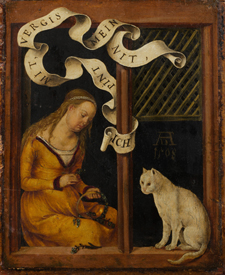
The forget-me-not’s associations with love and remembrance date to the Middle Ages, and were expressed in both the Old French and Middle High German names for this pretty little flower. Left: a pot of forget-me-nots on the parapet in Bonnefont garden. Photograph by Carly Still; Right: a young woman making a chaplet of forget-me-nots on the reverse of a portrait of a young man painted by Han Suess von Kulmbach. The legend on the banderole says “I bind with forget-me-nots.” See Collections for more information about this work of art.
A medieval symbol of love and remembrance that still decorated many a Victorian valentine, the forget-me-not (Myosotis scorpioides) was already known as ne m’oubliez mye in Old French and as vergiz min niht in Middle High German. The etymological and iconographic evidence for the forget-me-not’s medieval significance is ample, but the frequently repeated story of a German knight who tossed the forget-me-nots he had picked for his lady to her as he drowned, imploring her to remember him, is of the “as legend has it” variety. Margaret Freeman, who cites the use of forget-me-not as a token of steadfastness by several fifteenth-century German love poets, speculates that the color blue, associated with fidelity in the Middle Ages, may have contributed to the flower’s meaning.
Read more »
Tags: borage, Dioscorides, forget-me-not, Henry IV, Hildegard of Bingen, Myosotis scorpioides, scorpion, Scorpiurus sulcatus
Posted in Botany for Gardeners, Gardening at The Cloisters, Plants in Medieval Art | Comments (0)
Friday, April 5, 2013
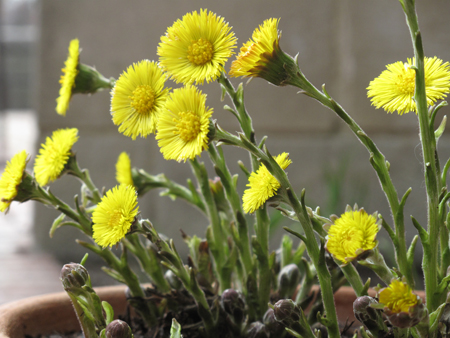
Coltsfoot blooming in a pot in Bonnefont garden. The scaly stems and bright yellow blossoms of this early-spring-blooming member of the daisy family emerge well before the foliage; the hoof-shaped leaves appear only after the flowers have set seed. This notoriously invasive Eurasian species is best grown in a container. Photograph by Carly Still
Tussilago farfara, known in the Middle Ages under the Latin names ungula caballina (”horse hoof”) and pes pulli (”foal’s foot”), is still called coltsfoot, ass’s foot, or bull’s foot in English, pas-de-poulain in French, pie d’asino in Italian, and hufflatich in German. These names all derive from the fancied resemblance of the young leaf to the foot of a quadruped. See an image of the plant in leaf. A slideshow of images of Tussilago farfara in all stages of growth is available at Arkive.org.
Read more »
Tags: Asteraceae, coltsfoot, Dioscorides, Hildegard of Bingen, Hortus Sanitatis, Pliny, tussilago
Posted in Gardening at The Cloisters, Medicinal Plants | Comments (4)
Thursday, October 4, 2012
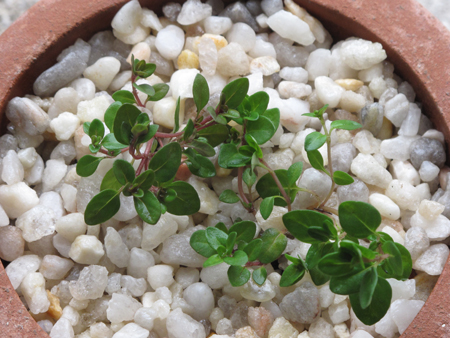
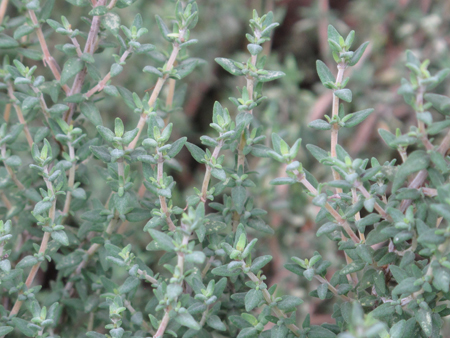
From right to left: A small start of wild or creeping thyme, a native of Northern Europe, in a terra rossa pot; detail of a planting of common or garden thyme, indigenous to the Western Mediterranean, growing in a sunny bed under the parapet wall in Bonnefont cloister. Although these two plants are easily distinguished in the garden, it can be difficult to know which of several species of thyme is under discussion in ancient and medieval sources.
There are hundreds of?? species in the genus Thymus, and a large and confusing array of hybrids and cultivated forms.??Ancient and medieval sources agree on the heating and drying properties of thyme, which is still greatly valued for its antibacterial and antifungal properties, but the species known in the European Middle Ages were not those of the ancients. The attempt to equate the plants discussed by Dioscorides in the De Materia Medica with more familiar species would occupy botanists well into the Renaissance.
Read more »
Tags: Dioscorides, Hildegard of Bingen, Pliny, thyme
Posted in Botany for Gardeners, Food and Beverage Plants, Fragrant Plants, Gardening at The Cloisters, Medicinal Plants | Comments (1)
Friday, September 21, 2012
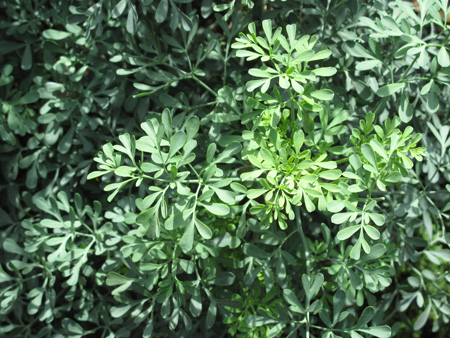
The blue-green fronds of rue were admired for their beauty in the Middle Ages, and the intensely aromatic leaves were prized as a condiment, a medicament, and an amulet.?? Photograph by Carly Still
Here is a shadowed grove which takes its color
From the miniature forest of glaucous rue.
Through its small leaves and short umbels which rise
Like clusters of spears it sends the wind???s breath
And the sun’s rays down to its roots below.
Touch it but gently and it yields a heavy
Fragrance. Many a healing power it has ???
Especially, they say, to combat
Hidden toxin and to expel from the bowels
The invading forces of noxious poison.
???Hortulus, Walahfrid Strabo, translated by Raef Payne
Read more »
Tags: Anethum graveolens, Apicius, Apium graveolens, bitter, Capitulare de Villis, Dioscorides, Hildegard of Bingen, Hortulus, Mithridates VI, mithridatum, phytodermatitis, Pliny, rue, Ruta graveolens, St. Gall, Tacuinum Sanitatis, Walahfrid Strabo
Posted in Food and Beverage Plants, Fragrant Plants, Gardening at The Cloisters, Magical Plants, Medicinal Plants | Comments (0)
Friday, September 14, 2012
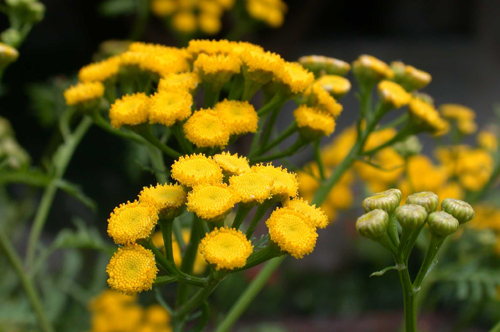
Unlike many of its relatives in the Asteraceae, or daisy family,??the golden disk flower of tansy is not surrounded by ray petals.??Although both the flowers and leaves are intensely bitter, tansy has a long history as a culinary herb.??
Tansy (reynfan) is hot and a bit moist, and is effective against all over-abundant humors which flow out. Whosoever has catarrh, and coughs because of it, should eat tansy, taken either in broth or small tarts, or with meat, or any other way. It checks the increase of the humors, and they vanish . . . .
???Hildegard of Bingen,??Physica,??Chapter CXI
The old German name reynfan used by Hildegard refers to the effect of tansy (Tanacetum vulgare) on the “reins,” or kidneys. The fifteenth-century herbal??Der Gart der Gesundheit differs from Hildegard in classifying tansy as hot and dry in the first degree, rather than moist; it recommends tansy as a diuretic and vermifuge, as well as a treatment for gout and fever. (For more on Hildegard of Bingen, see “Mutter Natur,” October 15, 2010. For more on the humoral theory on which her prescription is based, see “Cool, Cooler, Coolest,” July 27, 2012.) Read more »
Tags: Bonnefont Garden, daisy, Hildegard of Bingen, John Gerard, reynfan, Tanacetum, tansy, Walahfrid Strabo
Posted in Food and Beverage Plants, Gardening at The Cloisters, Medicinal Plants, The Medieval Garden | Comments (0)
Wednesday, August 15, 2012
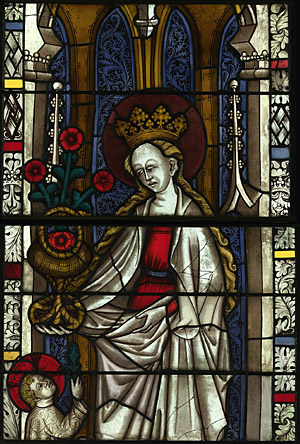
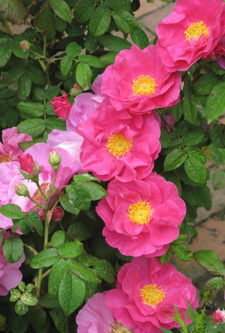
Left:?? Roses are one of the special attributes of Saint Dorothea, as shown in the detail of this stained-glass panel; Right: Rosa gallica officinalis blooming in Bonnefont garden. Remarkably, the rose has retained its ancient name in dozens of modern languages.
The rose has been known by the same name throughout Europe since antiquity. It began as vrda in ancient Persia (related to the modern Arabic warda) and became known as rhodon to the nearby ancient Greeks. (Oddly, the modern Greek for rose is triantafillo, meaning “thirty leaves,” while rhodon remains in our “rhododendron,” meaning “rose tree”). By the time of the Roman Empire the name had become rosa, immediately recognizable in most modern European languages???rosa (Italian and Spanish), roos (Dutch), ros (Swedish), rosier (French)???and many others, including the Japanese rozu.
Read more »
Tags: carline thistle, Dioscorides, etymology, herb robert, Hildegard of Bingen, Linnaeus, Physica, rose, Theophrastus
Posted in Botany for Gardeners | Comments (2)
Thursday, April 5, 2012
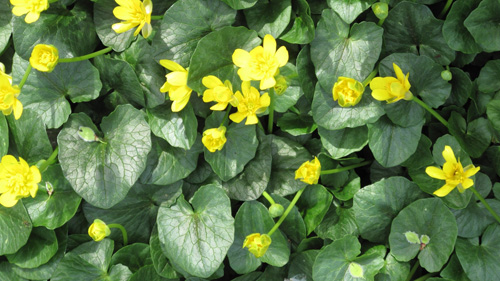
A colony of lesser celandine (Ranunculus ficaria) growing in the orchard below the south wall of Bonnefont garden.
The shining yellow flowers of lesser celandine star the grounds below Bonnefont garden in March and April, but the blossoms and the heart-shaped leaves of this spring ephemeral will disappear altogether by summer. The tuberous roots, which lie just beneath the surface of the soil, will remain dormant until the following spring. This invasive medieval species is not grown within the walls of The Cloisters, but has long been at home throughout the northeastern United States. (See the Ranunculus ficaria page of the Invasive Plant Atlas of New England website.)
Read more »
Tags: buttercup, celandine, Chelidonium majus, Hildegard of Bingen, Hortus Sanitatis, John Gerard, lesser celandine, poppy, Ranunculus ficaria, scrofula
Posted in Gardening at The Cloisters, Medicinal Plants | Comments (3)
Friday, March 23, 2012
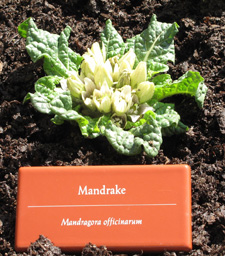
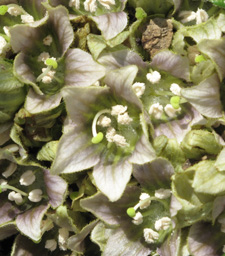
The mandrake, credited with both medicinal and magical powers over the course of many centuries, has accumulated more lore than any other plant in the Western tradition. Above: One of a colony of five spring-blooming mandrakes in Bonnefont garden. In March, this famous member of the nightshade family produces tight clusters of short-stemmed bell-shaped flowers.
Mandrake (mandragora) is hot and a little bit watery. It grew from the same earth which formed Adam, and resembles the human a bit. Because of its similarity to the human, the influence of the devil appears in it and stays with it, more than with other plants. Thus a person’s good or bad desires are accomplished by means of it, just as happened formerly with idols he made. When mandrake is dug from the earth, it should be placed in a spring immediately, for a day and a night, so that every evil and contrary humor is expelled from it, and it has no more power for magic or phantasms.
???Hildegard of Bingen, Physica (translated by Patricia Throop)
Read more »
Tags: alkaloid, Bartholomaeus Anglicus, Dioscorides, Hildegard of Bingen, John Gerard, Mandragora, Mandragora autumnalis, Mandragora officinarum, mandrake, nightshade, Pliny
Posted in Gardening at The Cloisters, Magical Plants, Medicinal Plants | Comments (10)
Friday, February 3, 2012
The trees went to anoint a king over them: and they said to the olive tree: Reign thou over us
And it answered: Can I leave my fatness, which both gods and men make use of, to come to be promoted among the trees?
???Judges 9: 8-9, Douay-Rheims Bible
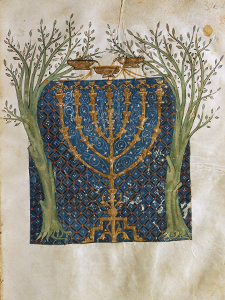

Olive oil provided fuel for sanctuary lamps throughout the Mediterranean world in antiquity and the Middle Ages, as well as holy oils for religious purposes. Above, left: A menorah flanked by two olive trees, as depicted in the Cervera Bible, recently on view at the Main Building. The brimming vessels?? used to fill the lamp appear at the top of the menorah. Right: A fifth-century standing lamp decorated with a cross; bronze lamps of this type were common in the early Byzantine world.
The olive was held to be the first of trees in both classical and biblical antiquity, prized above even the grapevine and the fig. A gift of the goddess Athena, the sacred olive symbolized the arts of peace and prosperity; the ruthless destruction of an enemy’s olive groves in wartime was held to be sacrilegious act. The Roman natural historian Pliny, writing in the first century A.D., attests that Athena’s olive was still venerated on the Athenian acropolis in his day (Historia naturalis, XVI 239???40). Although slow to bear, the tree is very long lived, surviving for hundreds of years. (The SpiceLines blog features an illustrated post about a Spanish olive estimated to be eighteen hundred years old.)
Read more »
Tags: chrism, drupe, glucoside, Hildegard of Bingen, Mediterranean, oil, oleaster, olive, Physica, Pliny, Tacuinum Sanitatis
Posted in Food and Beverage Plants, Medicinal Plants, Plants in Medieval Art, Useful Plants | Comments (0)
Friday, January 27, 2012
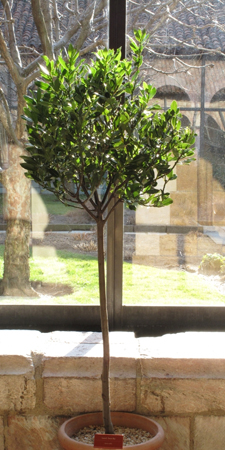
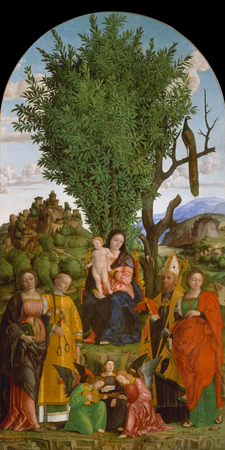
The evergreen bay laurel (Laurus nobilis), a symbol of victory and eternal life, is not as tender as some other Mediterranean species, but it must be grown in pots and wintered over indoors at The Cloisters. Above, left: Bay laurel topiaries like this one spend the winter in the glassed-in arcades of Cuxa cloister and return to Bonnefont herb garden in May. Right: The magnificent bay tree that flourishes at the center of Girolamo dai Libri’s Madonna and Child with Saints represents Resurrection, and is juxtaposed with the naked limbs of a dead tree.
The laurel itself is a bringer of peace, inasmuch as to hold a branch of it out even between enemy armies is a token of cessation of hostilities. With the Romans especially it is used as a harbinger of rejoicing and of victory, accompanying despatches and decorating the spears and javelins of the soldiery and adorning the generals??? rods of office. From this tree a branch is deposited in the lap of Jupiter the All-good and All-great whenever a fresh victory has brought rejoicing, and this is not because the laurel is continually green, nor yet because it is an emblem of peace, as the olive is to be preferred in both respects, but because it flourishes in the greatest beauty on Mount Parnassus, and consequently is thought to be also dear to Apollo, to whose shrine even the kings of Rome at that early date were in the custom of sending gifts and asking for oracles in return.
???Pliny, Historia Naturalis, Book XV, 133
Read more »
Tags: Apollo, bay, cinnamon, Daphne, Dioscorides, evergreen, Girolamo dai Libri, Hildegard of Bingen, Jashemski, laurel, Laurus nobilis, Ovid, Pliny, Pompeii
Posted in Gardening at The Cloisters, Medicinal Plants, Plants in Medieval Art, Useful Plants | Comments (1)
















